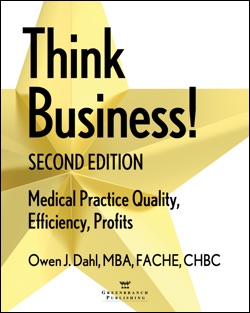Thousands of physicians and practice managers have relied on the previous edition of this book. In this revised and updated 2nd Edition, nationally recognized expert, Owen Dahl, provides the vital information that top business schools teach. Think Business! Is designed for the busy professional as a “mini-MBA” for the medical practice environment. Written in a clear style, the revised edition covers the changes occurring in healthcare and reimbursement including the move from volume to “value.” All examples and content relate to the daily operations and activities that occur in a healthcare practice.
New for SECOND Edition!
- Where to look first to control costs? We'll give you the first 3 places to look
- Complete overhaul of the Finance section
- MACRA, MIPS, PQRS, VBPM – Alphabet Soup
- How much does it cost you to see a patient? (cost differentials of new patient vs. established patient, one office vs. another office, one provider vs. another provider...
- Step-by-step guide to revenue cycle management (RCM)
- What is the expected profit margins on certain patient services?
- Basics of a strong compliance policy
- Risk Management: choose the MedMal policy right for you
- Volume to Value-based reimbursement
- How Scenario Planning works well in a medical practice
- Quadrant matrix to aid in decisions regarding ancillaries
- Tips on benchmarking the practice
- Avoiding risk of embezzlement
- Coaching behaviors
- Managing multi-generational teams
BONUS: Case studies that illustrate the change to pay-for-performance, risk management, ACA impact.
You can purchase the new book from Greenbranch Publishing here, or on Amazon here.





